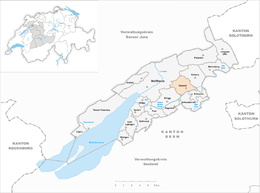Orpund
| Orpund | |
|---|---|

Gotthouse Monastery Church in Orpund
|
|
| Coordinates: 47°8′N 7°18′E / 47.133°N 7.300°ECoordinates: 47°8′N 7°18′E / 47.133°N 7.300°E | |
| Country | Switzerland |
| Canton | Bern |
| District | Biel/Bienne |
| Area | |
| • Total | 3.96 km2 (1.53 sq mi) |
| Elevation | 483 m (1,585 ft) |
| Population (Dec 2015) | |
| • Total | 2,675 |
| • Density | 680/km2 (1,700/sq mi) |
| Postal code | 2552 |
| SFOS number | 0744 |
| Surrounded by | Biel/Bienne, Brügg, Safnern, Scheuren, Schwadernau |
| Twin towns | Brtnice (Czech Republic) |
| Website |
www SFSO statistics |
Orpund is a municipality in the Biel/Bienne administrative district in the canton of Bern in Switzerland.
Orpund is first mentioned in 1255 as Orpunt. The municipality was formerly known by its unknown name er Orpondes, however, that name is no longer used.
The oldest traces of settlements in the area were neolithic, Bronze Age and La Tène era artifacts which were discovered during construction of the Nidau-Büren Canal. A horde of Bronze Age items and a Roman era settlement were found on the Büttenberg. During the Middle Ages, the Counts of Neuchâtel-Nidau founded a monastery at Gottstatt and gave the village of Orpund to the monastery. The village and the monastery jointly owned an island in the Thielle/Zihl river, which they used for fishing. At the end of the 14th century, Bern acquired all the lands around Nidau and Orpund was incorporated into the Bernese bailiwick of Nidau. Part of the village was in the parish of Mett while the rest belonged to the parish church located on the Büttenberg hill near Orpund. During the Protestant Reformation of 1528, Gottstatt Monastery was secularized and the monastery church became the parish church for all of Orpund.
On 8 May 1778 eight houses in the village burned to the ground. After the fire they were all rebuilt. However, the straw roofing and close quarters made another fire almost inevitable. On 24 February 1868 three houses were destroyed in a fire. This was followed by a major fire on 26 May 1868 which destroyed 26 houses and damaged several others. According to an 1808 survey, there were about 40 houses in the entire village.
...
Wikipedia



